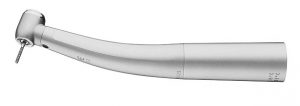 In today’s world, dental practitioners are exceptionally dependent upon dental handpieces. The various types of dental handpieces available today are used in restorative dentistry, prosthodontics, and surgical procedures. According to numerous studies, dental handpieces are considered to be one of the most often used rotary mechanical-based devices in today’s dentistry. The traditional handpieces available today include the electric-drive and the air-driven model. Recently, a handpiece was released that utilizes the unique technologies from both the electric-driven models and the air-driven models. For the purpose and intent of this particular guide, we will place a special emphasis on the latest improvements in air-driven dental handpieces.
In today’s world, dental practitioners are exceptionally dependent upon dental handpieces. The various types of dental handpieces available today are used in restorative dentistry, prosthodontics, and surgical procedures. According to numerous studies, dental handpieces are considered to be one of the most often used rotary mechanical-based devices in today’s dentistry. The traditional handpieces available today include the electric-drive and the air-driven model. Recently, a handpiece was released that utilizes the unique technologies from both the electric-driven models and the air-driven models. For the purpose and intent of this particular guide, we will place a special emphasis on the latest improvements in air-driven dental handpieces.
The Head Size & Device Angulation
The air-driven dental handpieces that are currently available in today’s market have a much smaller head than their traditional counterparts. The reduction in head size optimizes the overall visibility of the practitioner and the access that the dentist has to various regions within the mouth. Due to the smaller-sized heads, there is less of an opportunity for the operator to experience fatigue during procedures. Most dental handpieces have a 22.5 degree angled head. This allows the device to remain within the line of the sight of the operator. Unfortunately, this angle typically results in restrictions to the access of the teeth located in the posterior region of the mouth. As a result, the handpiece will come in direct contact with the maxillary arch. The new angles on air-driven handpieces allow practitioners to avoid this complication. Furthermore, the angle increases access to the posterior region of the mouth, therefore, optimizing patient comfort levels.
Optimized Ergonomic-Based Design
Older air-driven handpieces have been found to increase the risk of certain health complications to develop, such as the onset of carpel tunnel syndrome. Recently, dental practitioners have started leaning towards newer air-driven handpieces because of the fact that the device is shaped with a wider and more flared shape towards the bottom rear of the device. This reduces the overall level of pinching force that is required to get a good grip on the handpiece. This aids in the elimination of hand fatigue and wrist fatigue. Furthermore, a swivel that fully rotates has been added to the air-driven handpieces so that the tubing torque associated with the device is no longer felt by the practitioner during use.
The Autoclavability
Throughout the history of air-driven dental handpieces, the materials associated with the bearing retainers, the o-rings, and the external area have evolved immensely. Now, all of these aspects of the air-driven dental handpieces are capable of withstanding high temperatures and higher levels of heat. New, specially-designed materials such as the ever-flexible, lightweight material, titanium, are used for the body of the dental handpieces. Furthermore, specially-designed coatings are now applied to various aspects of the handpieces to preserve their finishes.
Conclusion
As you can see, there are many distinctive features and improvements associated with air-driven dental handpieces. If you are a practitioner, it is a good idea to have a combination of electric-driven and air-driven handpieces in your practice. This will allow you to experience the highest level of flexibility when it comes to restorative dentistry, surgical procedures, and other dental jobs. Once you purchase your dental handpieces, it is imperative that you make certain that you set up a regular maintenance schedule to care for those pieces. If you would like assistance on maintaining your air-driven dental pieces, contact us today by calling: 800-773-0800 We also sell dental handpieces, check out our store
